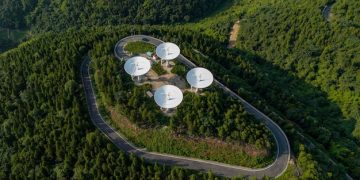US Fusion Energy: Latest Research & Prototype Expectation

The United States is witnessing significant advancements in fusion energy research, with private and public sectors accelerating development towards a potential working prototype within the next decade, though widespread commercial deployment remains a longer-term goal.
The quest for clean, virtually limitless energy has long fueled scientific imagination, and nowhere is this more evident than in the pursuit of nuclear fusion. In the United States, significant strides are being made, with both public institutions and ambitious private ventures pushing the boundaries of what’s possible. But what’s the latest on fusion energy research in the US and when can we expect a working prototype? This question delves into the heart of cutting-edge physics, engineering, and substantial investment, promising a future powered by the same reactions that light our sun.
The american fusion landscape: a renewed sense of urgency
The United States has long been a key player in fusion research, contributing significantly to global efforts while also fostering a robust domestic program. However, recent years have observed a palpable shift, moving from predominantly academic and long-term fundamental research to an increased emphasis on engineering solutions and accelerating the path to practical energy generation.
This evolving landscape is greatly influenced by a confluence of factors, including the pressing global need for carbon-free energy, breakthroughs in material science and computing, and a surge in private capital flowing into fusion startups. The traditional narrative of fusion being “always 30 years away” is now being actively challenged by a new generation of scientists and entrepreneurs.
public sector initiatives leading the charge
Government-backed institutions like the Department of Energy’s (DOE) National Laboratories are foundational to the US fusion effort. These labs house some of the most powerful and sophisticated experimental facilities globally, conducting critical research into plasma confinement, heating, and stability. Their work often involves large-scale, intricate experiments designed to understand the fundamental physics necessary for controlled fusion reactions.
- Princeton Plasma Physics Laboratory (PPPL): A leader in tokamak research, operating facilities like NSTX-U to study plasma behavior in a toroidal magnetic field.
- Lawrence Livermore National Laboratory (LLNL): Home to the National Ignition Facility (NIF), focusing on inertial confinement fusion using powerful lasers to compress and heat fuel pellets.
- Oak Ridge National Laboratory (ORNL): Contributing through materials science, high-performance computing, and developing advanced diagnostics for fusion reactors.
These public initiatives not only push scientific boundaries but also cultivate a deep talent pool, providing the foundational knowledge and skilled personnel necessary for the entire fusion ecosystem to thrive. The long-term, stable funding from the government allows for riskier, longer-horizon research that might not appeal to private investors seeking quicker returns.
The renewed emphasis within the public sector often involves strategic partnerships and funding opportunities designed to bridge the gap between basic research and commercial viability. This includes programs that support private sector innovation, recognizing that a hybrid approach is likely the fastest way to achieve a working prototype. The urgency to address climate change has also provided a significant tailwind, elevating fusion’s priority within national energy strategies.
private sector boom: venture capital and diverse approaches
Perhaps the most dynamic shift in the US fusion landscape is the meteoric rise of the private sector. Over the past decade, venture capital has poured billions of dollars into fusion startups, each often pursuing unique and innovative approaches to achieving fusion, moving beyond the traditional tokamak and inertial confinement methods.
This influx of private funding brings a different business acumen to fusion development: a focus on rapid prototyping, iterative design, and a clear path to commercialization. These companies are not necessarily reinventing the physics but are applying modern engineering and manufacturing techniques to accelerate development cycles.
key players and their innovative concepts
The private fusion sector in the US is incredibly diverse, with companies exploring a wide array of confinement strategies and fuel cycles. This diversity increases the probability of a breakthrough, as different approaches mitigate different technical challenges.
- Commonwealth Fusion Systems (CFS): Spun out of MIT, CFS is developing compact, high-field tokamaks using high-temperature superconducting (HTS) magnets. Their SPARC project aims to demonstrate net energy gain, paving the way for their ARC commercial reactor.
- Helion Energy: Focused on field-reversed configuration (FRC) devices and direct energy conversion, aiming for smaller, more modular fusion power plants that can also directly convert kinetic energy from the plasma into electricity.
- TAE Technologies: Also pursuing FRCs, TAE focuses on advanced fuels like hydrogen-boron (aneutronic fusion), which promises less radioactive waste and potentially simpler reactor designs.
These are just a few examples of the dozens of private companies actively working on fusion in the US. Their rapid progress is often attributed to leaner organizational structures, the ability to make quick design decisions, and leveraging advancements in other fields like superconducting materials, artificial intelligence for plasma control, and additive manufacturing. The competitive environment also fosters innovation, pushing each company to accelerate its timeline.
The private sector’s ability to attract significant investment is a testament to the growing confidence in fusion’s potential. Investors are increasingly seeing fusion not as a distant science project, but as a viable, albeit high-risk, energy technology with immense returns if successful. This is fundamentally altering the pace and direction of fusion research in the United States.

milestones and breakthroughs: measuring progress
Measuring progress in fusion research isn’t always about a single “eureka” moment but rather a series of incremental, yet profound, breakthroughs. In the US, recent years have witnessed several significant milestones that underscore the accelerating pace of development.
One of the most widely celebrated achievements came from Lawrence Livermore National Laboratory’s National Ignition Facility (NIF). In December 2022, NIF successfully achieved “ignition” – producing more energy from a fusion reaction than the laser energy used to create it. This was a monumental scientific achievement, proving a fundamental principle of inertial confinement fusion that had been a goal for decades.
beyond scientific ignition: the path to Q>1 in magnetic confinement
While NIF’s achievement was groundbreaking for inertial confinement, the majority of private and public sector efforts in the US focus on magnetic confinement fusion, primarily using tokamak devices. Here, the equivalent benchmark is achieving Q>1, meaning the fusion power produced exceeds the power required to heat the plasma.
- SPARC’s Success: Commonwealth Fusion Systems (CFS) made headlines with the successful testing of their SPARC project’s high-temperature superconducting (HTS) magnets, demonstrating they can generate magnetic fields strong enough to enable net energy gain in a compact tokamak.
- Continuous advancements in plasma control: Researchers are increasingly using AI and machine learning to predict and control plasma instabilities, improving confinement times and efficiency in real-time.
- New materials development: The search for materials that can withstand the extreme neutron flux and high temperatures inside a fusion reactor is critical. Innovations in alloys and composites are steadily improving reactor design longevity.
These milestones, whether in scientific proof-of-concept, component validation, or operational efficiency, collectively build confidence in the technological pathway to fusion power. They signal a shift from theoretical modeling to practical engineering demonstrations, indicating that the challenges are being systematically tackled.
The emphasis is now less on demonstrating whether fusion is possible, and more on how to make it economically viable and scalable. Each successful experiment or component test provides invaluable data, informing the design of the next generation of fusion devices and bringing the prospect of a working prototype closer to reality.
regulatory landscape and funding mechanisms
The regulatory environment for fusion energy is a critical, yet often overlooked, aspect of its development. Unlike traditional nuclear fission power, fusion does not produce long-lived radioactive waste and poses considerably different, and generally lower, safety risks. The US Nuclear Regulatory Commission (NRC) has been actively working on developing a fit-for-purpose regulatory framework for fusion, distinct from fission regulations.
In 2023, the NRC issued a policy statement clarifying its intent to regulate fusion energy as a material license, rather than a reactor license, which is a significant departure from fission. This move is seen as highly favorable by the fusion industry, as it avoids unnecessarily burdensome regulations designed for fission, which could stifle innovation and increase development costs significantly.
federal funding and strategic partnerships
Beyond private venture capital, federal funding remains essential for de-risking early-stage technologies and supporting foundational research. The DOE’s Fusion Energy Sciences (FES) program is the primary federal funding body, distributing grants to national labs, universities, and increasingly, private companies.
- Milestone-based funding: The DOE has implemented programs that provide funding to private companies based on achieving specific technical milestones, incentivizing rapid progress and accountability.
- Public-private partnerships: Collaborations between national laboratories and private companies are becoming more common, allowing startups to leverage government facilities and expertise, while labs benefit from industry’s agile development pace.
- International collaborations: The US continues to participate in international projects like ITER, gaining valuable insights and sharing the massive costs associated with large-scale fusion experiments.
The Bipartisan Infrastructure Law and other legislative initiatives have also provided significant boosts to fusion research funding, reflecting a national commitment to advanced energy technologies. This strategic investment is crucial for overcoming the remaining engineering hurdles and ensuring the US remains at the forefront of fusion development.
The evolving regulatory and funding landscape demonstrates a proactive approach from the US government to enable rather than impede fusion development. This supportive environment creates a more predictable pathway for companies to invest, build, and eventually deploy fusion power plants, attracting further innovation and capital.
prototype expectations: when can we see a working machine?
The question on everyone’s mind: when will we actually see a working fusion prototype? Defining “working prototype” is key. For many in the field, this means a device that consistently produces more energy than it consumes (net energy gain), operating reliably for sustained periods, and demonstrating the ability to generate electricity, even if not at commercial scale.
Based on current trajectories and the ambitious plans of leading US-based companies, several players are targeting prototypes achieving net energy gain (Q>1) by the late 2020s or early 2030s. Commonwealth Fusion Systems, for example, is aiming for net energy demonstration with their SPARC device around 2025-2026, followed by their commercial-scale ARC plant in the early 2030s.
challenges beyond ignition: the engineering hurdles
While achieving scientific ignition or Q>1 is a monumental step, it’s not the final destination. The journey to a commercial fusion power plant involves overcoming several complex engineering challenges:
- Material science: Developing materials that can withstand the extreme conditions inside a fusion reactor, including intense neutron bombardment and high heat fluxes, for decades of operation.
- Fuel cycle: Efficiently breeding tritium (a key fuel for D-T fusion) within the reactor, removing impurities, and handling the fuel safely.
- Heat extraction and electricity generation: Designing efficient ways to extract heat from the fusion reaction and convert it into usable electricity on an industrial scale.
Each of these challenges requires significant research and development, often involving interdisciplinary teams of engineers, physicists, and material scientists. The timeline for addressing these issues is less predictable than scientific breakthroughs, as they often involve iterative design, testing, and optimization.
Optimism within the fusion community is high, with many believing that a grid-connected fusion prototype, demonstrating all necessary aspects of energy generation, could be online within the next 10-15 years. This timeline is significantly more aggressive than forecasts from a decade ago, largely due to the infusion of private capital and the more agile development methodologies employed by private companies.
The race is on, with US entities playing a leading role in pushing the boundaries of what was once considered science fiction into the realm of engineering reality. While challenges persist, the path forward is clearer than ever before, with tangible progress being made year by year.

potential impact: transforming the energy landscape
The successful deployment of fusion energy would represent a paradigm shift in the global energy landscape, offering a revolutionary path towards a sustainable and secure future. Its potential benefits are manifold, addressing some of the most pressing challenges facing humanity, from climate change to energy security.
Perhaps the most significant impact is the promise of virtually limitless, clean energy. Fusion fuel (deuterium derived from water, and tritium, which can be bred from lithium) is abundant, meaning that once scaled, fusion could provide energy for millions of years with minimal resource depletion. This independence from finite fossil fuels would stabilize energy markets and reduce geopolitical tensions often associated with energy resource competition.
environmental and societal benefits
From an environmental perspective, fusion power is inherently clean. It produces no greenhouse gases during operation, addressing a critical need in combating climate change. Unlike fission, fusion reactors produce significantly less radioactive waste, and the waste produced has a much shorter half-life, simplifying disposal and reducing the long-term environmental burden.
- Enhanced grid stability: Fusion power plants could offer baseload power, providing a constant, reliable electricity supply that complements intermittent renewables like solar and wind, enhancing grid stability and resilience.
- Minimal meltdown risk: The nature of fusion reactions means a runaway chain reaction is impossible. If any anomaly occurs, the plasma cools almost instantly, effectively shutting down the reactor without risk of meltdown, making it intrinsically safer than fission.
- Economic growth and job creation: Developing and deploying fusion technology would create a vast new industry, generating high-tech jobs in engineering, manufacturing, research, and operations, stimulating economic growth globally.
Societally, cheap, abundant energy enables widespread economic development, lifts communities out of energy poverty, and supports technological advancements across all sectors. Imagine cities powered by clean energy, desalinization plants providing fresh water to arid regions, and industries operating with a drastically reduced carbon footprint – all enabled by fusion.
While the journey has been long and complex, the potential rewards are immense. The current pace of innovation in the US, driven by both public and private sectors, suggests that this transformative technology is inching closer to becoming a reality, poised to redefine how we power our world.
As research intensifies and funding diversifies, the dream of fusion energy for all is gradually shedding its label as a distant aspiration and taking on the form of a tangible, achievable goal. The coming decades will undoubtedly be a pivotal period in the history of energy, with the US at the forefront of this monumental scientific and engineering endeavor.
| Key Aspect | Brief Overview |
|---|---|
| 💡 Research Focus | US research blends public scientific foundations (tokamaks, inertial confinement) with agile private sector engineering innovations. |
| 🚀 Key Milestones | Recent breakthroughs include NIF’s ignition success and HTS magnet validation for compact tokamaks. |
| 🗓️ Prototype Expectation | Net energy gain prototypes aimed for late 2020s/early 2030s, with commercial plants following. |
| 🌍 Societal Impact | Promises virtually limitless, clean energy with minimal waste, enhancing energy security and sustainability. |
frequently asked questions about fusion energy
▼
Nuclear fusion involves combining light atomic nuclei (like hydrogen isotopes) to form a heavier nucleus, releasing immense energy. Nuclear fission, conversely, splits heavy atomic nuclei (like uranium) into smaller ones. Fusion fuels are abundant and produce little long-lived radioactive waste, unlike fission.
▼
Achieving fusion requires extreme conditions: temperatures hotter than the sun and immense pressure to force nuclei to fuse. Sustaining these conditions for long enough to produce net energy, while developing materials that can withstand the environment, presents significant scientific and engineering challenges that scientists are now overcoming.
▼
Net energy gain (often denoted as Q>1) means the fusion device produces more energy from the fusion reaction than the energy put into heating the plasma to initiate and sustain the reaction. It’s a critical milestone, demonstrating that the process is energy-positive, moving beyond scientific proof-of-concept towards practical energy generation.
▼
Private funding has dramatically accelerated innovation by enabling diverse approaches, fostering rapid prototyping, and introducing agile business models. This capital complements public funding, de-risking technologies and speeding up the timeline for commercialization, leading to a much more dynamic and competitive landscape.
▼
The main types include magnetic confinement (primarily tokamaks, like those developed by CFS and PPPL, which use magnetic fields to contain hot plasma) and inertial confinement (like LLNL’s NIF, which uses lasers to rapidly compress fuel pellets). Private companies are also exploring field-reversed configurations (Helion, TAE) and other novel designs.
the dawn of a new energy era
The journey toward practical fusion energy is a testament to human ingenuity and perseverance. In the United States, the convergence of robust public sector research, groundbreaking private sector innovation, and a supportive regulatory and funding environment is rapidly shifting fusion from a distant dream to an approaching reality. As the scientific and engineering hurdles are systematically addressed, the prospect of a working prototype capable of net energy gain within the next decade is no longer mere speculation, but a tangible goal. This exciting progress promises to unlock an abundant, clean, and safe energy source, fundamentally transforming our world and securing a sustainable future for generations to come, truly marking the dawn of a new energy era.





